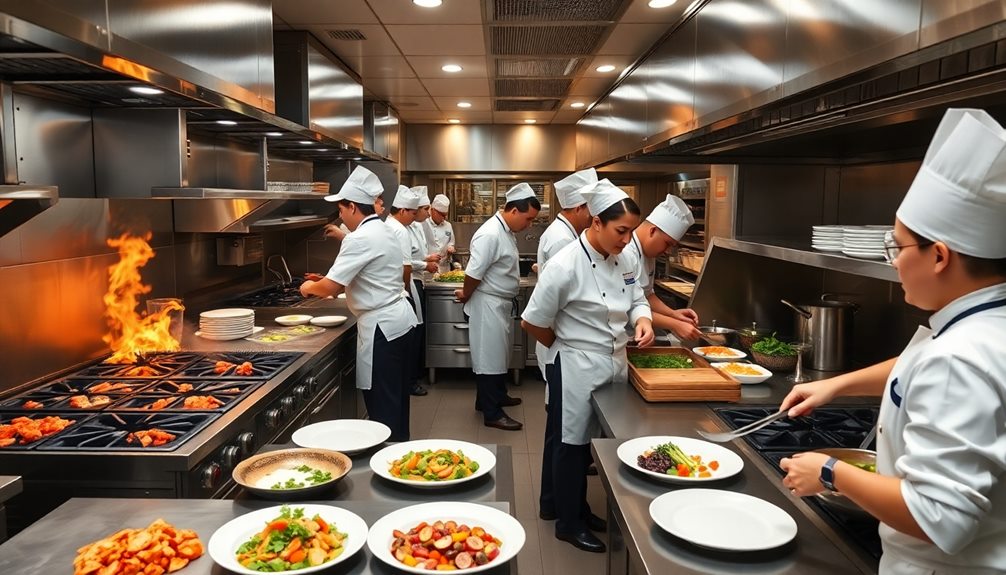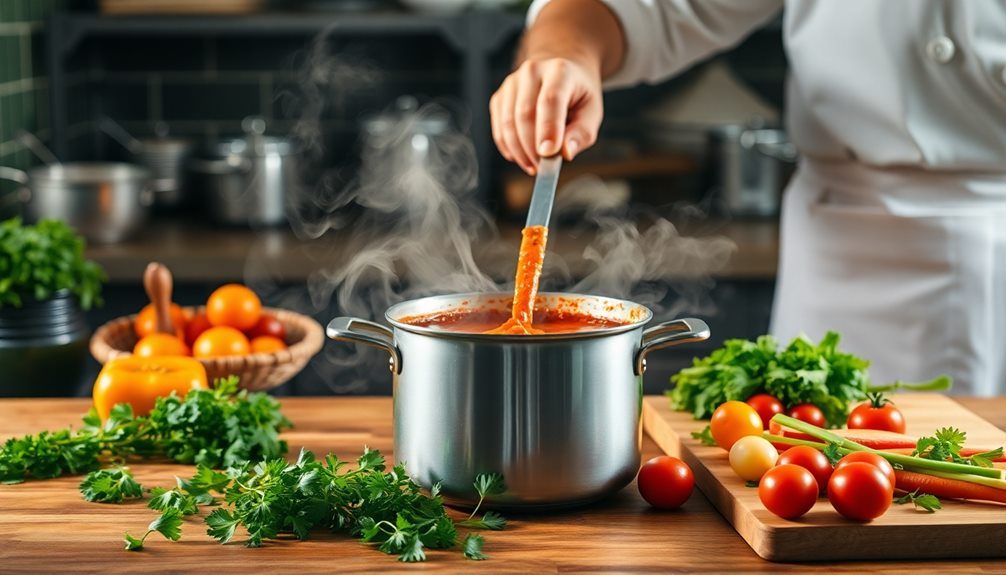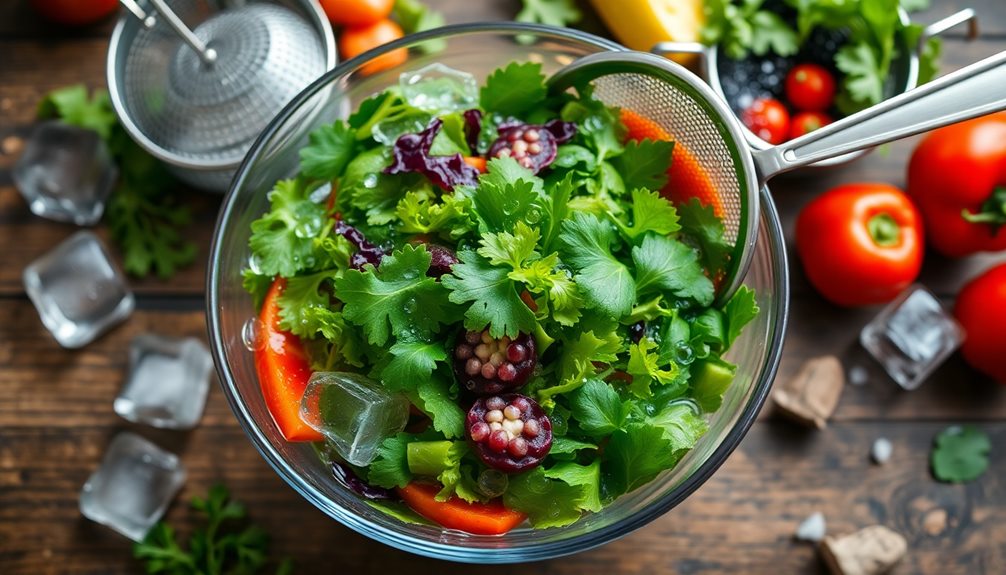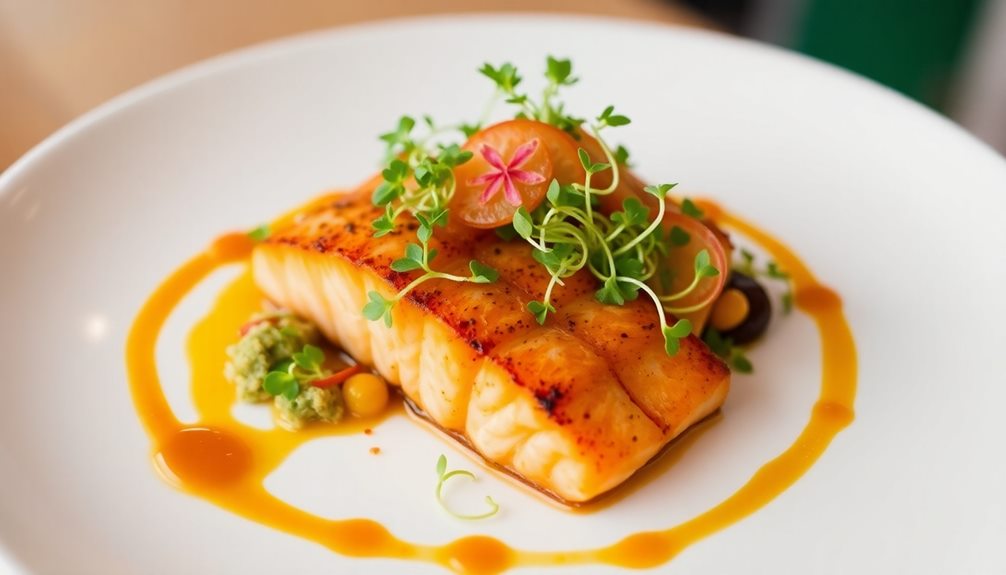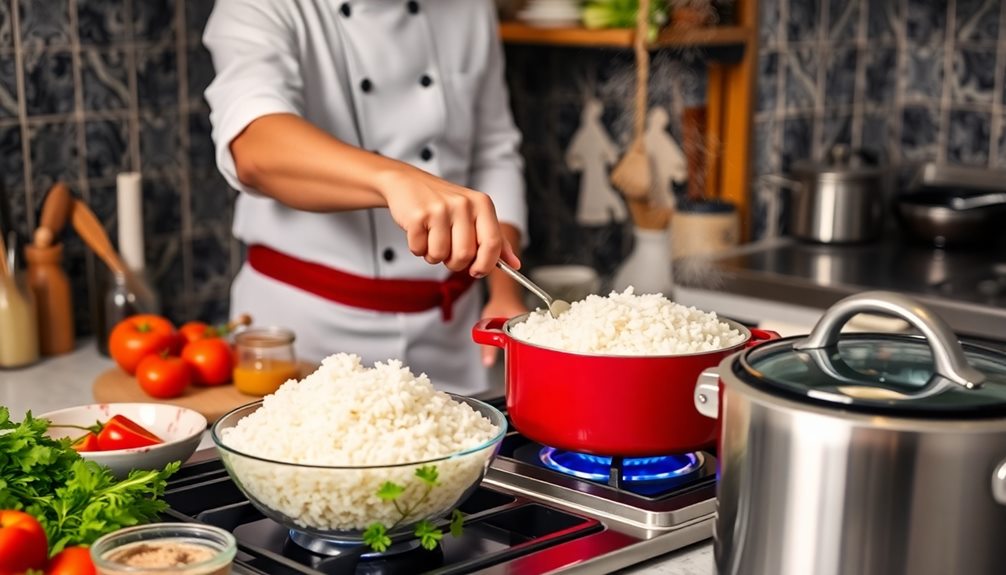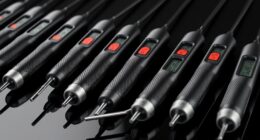Restaurants prepare food quickly by using techniques like mise en place and batch production, ensuring all ingredients are ready for assembly. They rely on specialized cooking equipment, such as high-efficiency ovens and commercial grills, to speed up cooking times. Staff coordination is key too; designated roles and strong communication help manage multiple orders efficiently. Additionally, pre-cooked meats and frozen ingredients reduce prep time while maintaining quality. By focusing on these strategies, restaurants serve fresh meals swiftly without sacrificing taste. If you're curious about more methods they use, there's plenty more to discover.
Key Takeaways
- Restaurants utilize mise en place to organize ingredients, enabling quick assembly during peak service hours.
- Pre-cooked meats and frozen ingredients reduce cooking times while maintaining flavor and quality.
- Efficient cooking equipment, like high-efficiency ovens and commercial grills, allows for faster preparation of multiple orders.
- Staff coordination through designated roles and strong communication ensures timely and synchronized order preparation.
- Batch production of sauces and standardized recipes help streamline cooking processes and maintain flavor consistency.
Pre-Preparation Techniques
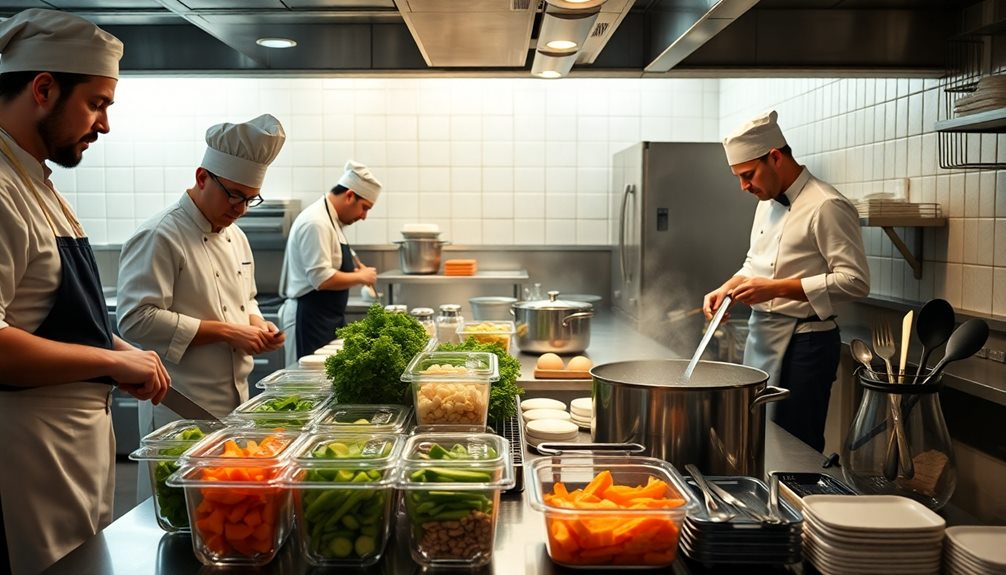
In the bustling world of restaurants, effective pre-preparation techniques are vital for speedy service. You'll often find that successful kitchens rely on the principle of mise en place, which means "everything in its place." This method guarantees all ingredients are organized and ready for quick assembly during peak hours.
Daily prep work is important, and that often involves making large batches of base sauces and gravies. With these prepared, you can customize dishes rapidly, enhancing your efficiency.
Using pre-cooked meats is another time-saver. By reheating these items, you greatly reduce cooking time while still delivering flavor-packed meals.
Additionally, efficient kitchen organization, including pre-cut vegetables and marinated proteins, streamlines the cooking process even further. You'll notice that batch cooking staple items like sauces and stocks allows you to manage multiple orders simultaneously, securing consistency in quality.
Efficient Cooking Equipment
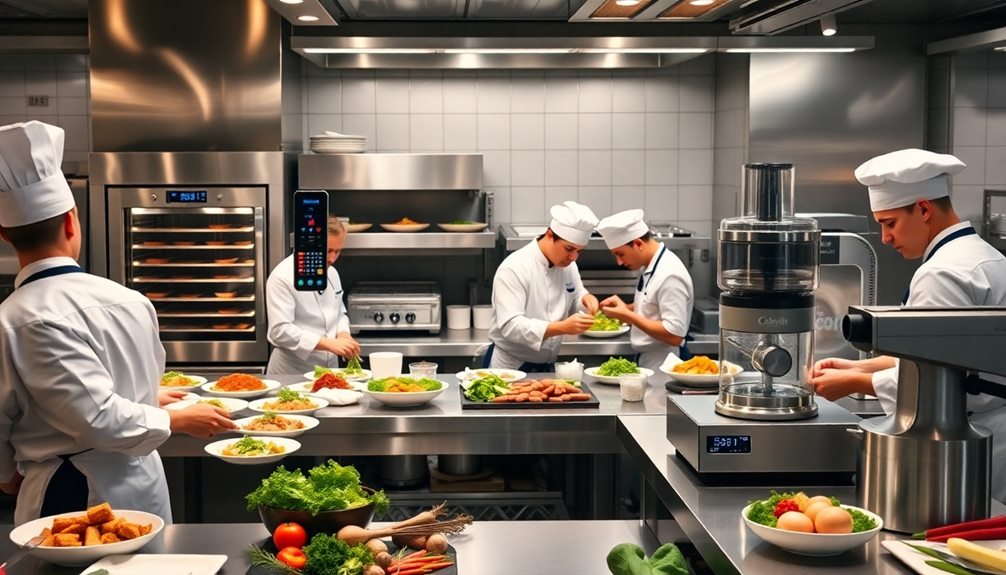
When it comes to speeding up food preparation, efficient cooking equipment plays an essential role in restaurant kitchens. In fast-paced environments, the right tools can make a significant difference in cooking processes and overall service speed.
Here are three types of efficient cooking equipment that are commonly used:
- High-Efficiency Ovens and Induction Cooktops: These appliances reach high temperatures quickly, allowing chefs to cook food faster than conventional equipment.
- Specialized Tools: Commercial grills and pasta cookers enable the rapid cooking of multiple orders at once, which helps reduce wait times for customers.
- Steam Boxes and Blast Chillers: These tools guarantee even cooking and rapid cooling, enhancing food safety and preparation speed.
Moreover, microwaves are frequently utilized in fast food settings for quick reheating and finishing of partially cooked items. This approach enhances service speed without compromising quality.
The layout of professional kitchens is also strategically designed to facilitate teamwork, making it easier for chefs to use efficient cooking equipment while managing various cooking processes simultaneously.
This combination of tools and layout guarantees that restaurants can serve delicious meals promptly.
Staff Coordination Strategies
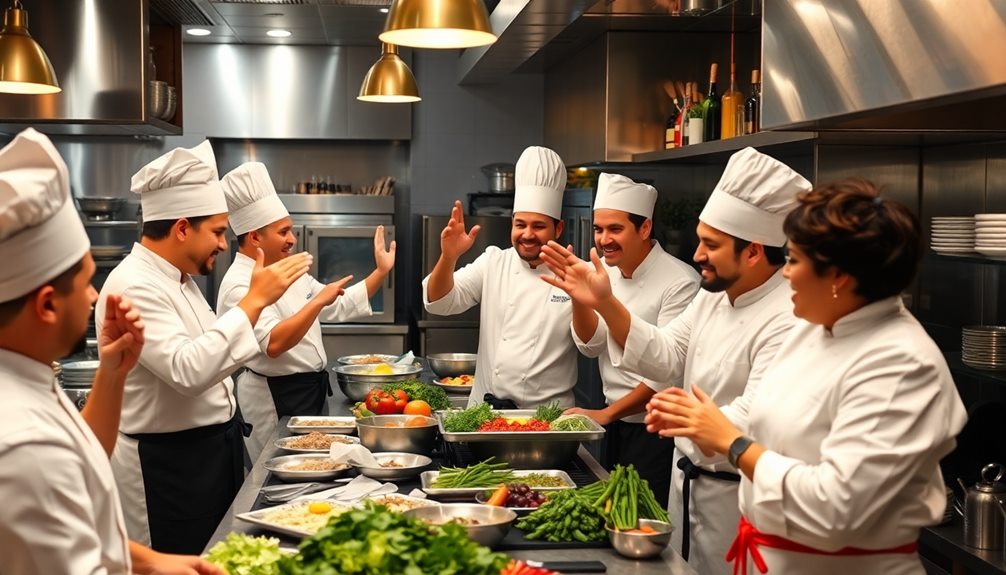
Effective staff coordination is essential for a restaurant's success, especially during peak hours. To achieve this, you should assign designated roles, like prep cooks and line cooks, which streamlines operations and guarantees quick assembly of dishes.
Strong communication among your kitchen staff is critical; it allows for synchronized timing and adjustments, enabling multiple orders to be prepared simultaneously.
As an experienced chef, you'll often need to manage several cooking processes at once. By honing your multitasking skills, you can enhance workflow and greatly reduce preparation times.
Integrating food expeditors into your kitchen setup also plays an important role. They help guarantee dishes are cooked in the correct sequence and served promptly, maintaining the overall flow of service.
Lastly, regular training and feedback sessions are key in cultivating teamwork. These practices enhance your staff's ability to adapt quickly to the dynamic demands of a busy kitchen environment.
When everyone works together seamlessly, it not only boosts efficiency but also creates a positive atmosphere that can elevate the dining experience for your customers.
Use of Frozen Ingredients
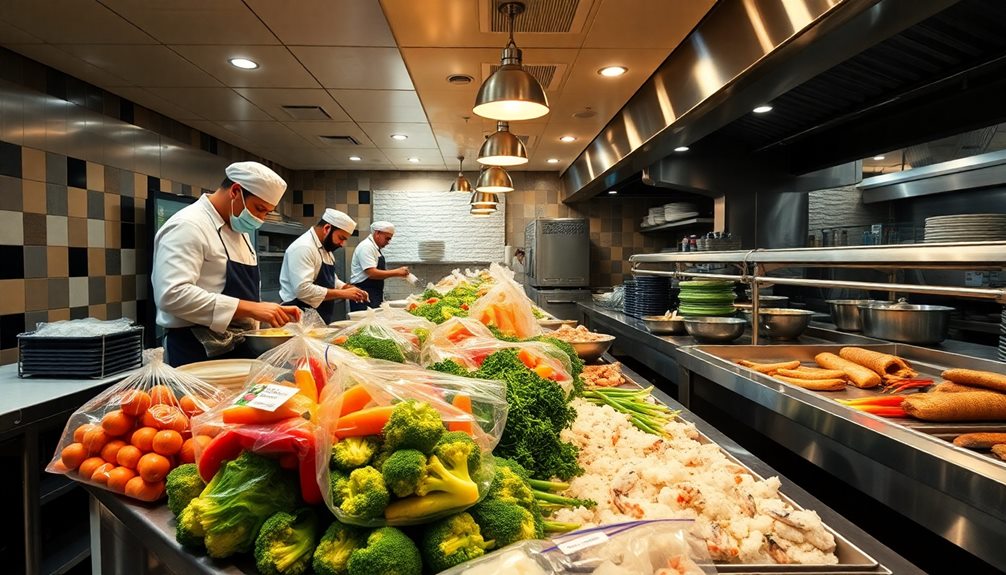
Using frozen ingredients can greatly enhance your restaurant's efficiency and speed during service. These ingredients help you reduce preparation time, allowing your team to focus on meal assembly and customer service.
Here are three key benefits of using frozen ingredients:
- Time-saving: Frozen produce is often pre-washed, cut, and blanched. This means you can quickly thaw and cook them, considerably cutting down on the time needed for ingredient prep.
- Consistency: Relying on frozen pre-made items like doughs, sauces, and entrees guarantees that each dish maintains the same quality, speeding up meal assembly while adhering to your restaurant's standards.
- Reduced food waste: By using frozen ingredients, you can keep items for longer periods, minimizing spoilage. This helps manage inventory effectively and cuts down on costs associated with food waste.
Moreover, quality control measures are essential when working with frozen ingredients, guaranteeing they meet your restaurant's high standards.
Flavor Development Methods
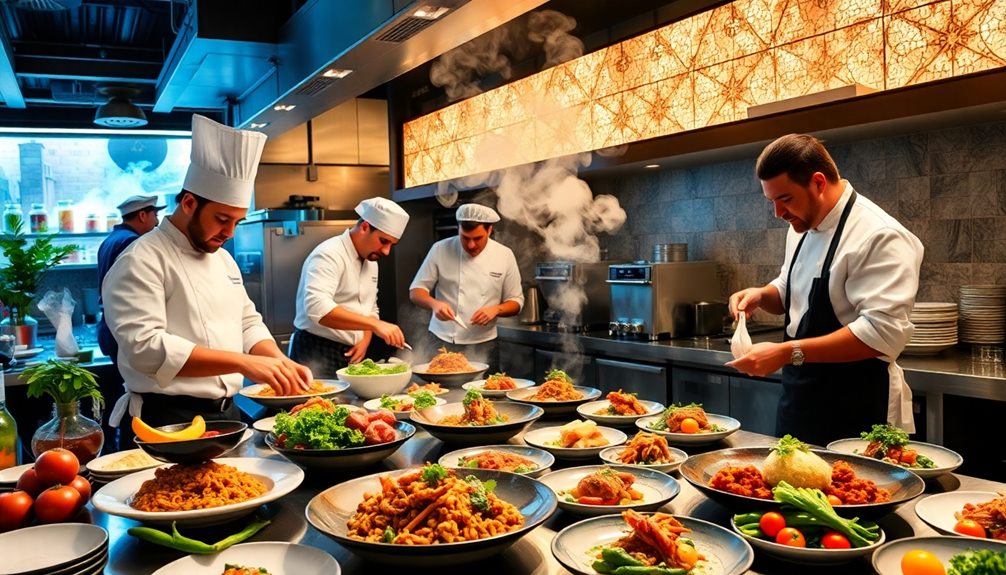
Flavor development methods play an essential role in how restaurants create delicious dishes efficiently. By preparing base sauces and gravies in large batches, chefs can quickly adjust flavors with various spices and ingredients, tailoring them to different dishes. This not only saves time but also enhances the overall quality of the food.
Pre-marinated proteins and pre-prepped vegetables allow you to boost flavor without lengthy cooking times. Also, letting dishes sit for a short period after preparation helps flavors meld together, enhancing the dining experience. Utilizing standardized recipes guarantees flavor consistency while streamlining the cooking process.
Techniques such as blanching vegetables or using sous-vide cooking can expedite flavor development. Blanching retains color and texture, while sous-vide assures even doneness, elevating the final taste of your dishes.
These methods help you serve flavorful food quickly, making sure that your customers enjoy every bite without delay. Incorporating these flavor development techniques not only makes your kitchen more efficient but also keeps your dishes consistently delicious, allowing you to impress diners with both speed and quality.
Inventory Management Practices
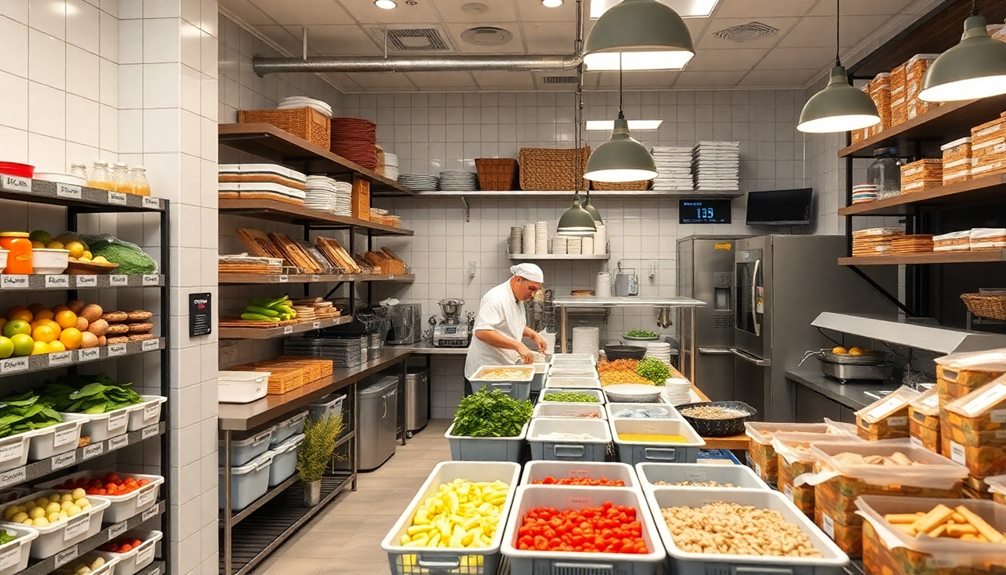
When you manage inventory effectively, you're not just keeping track of ingredients; you're also ensuring that everything stays fresh and ready for use.
By rotating stock efficiently and simplifying your menu, you can minimize waste and streamline operations.
This approach not only saves time but also enhances the overall dining experience for your customers.
Efficient Stock Rotation
Effective stock rotation is essential for restaurants aiming to minimize waste and maintain ingredient freshness. By implementing efficient practices, you can greatly reduce food waste and enhance your inventory management.
Here are three key strategies to take into account:
- First In, First Out (FIFO): Always use the FIFO method to guarantee older stock is utilized before newer items. This approach keeps ingredients fresh and reduces spoilage.
- Labeling System: Implement a clear labeling system with expiration dates. This allows your kitchen staff to quickly identify which items need to be used first, promoting efficiency and preventing waste.
- Regular Inventory Audits: Conduct regular audits to identify slow-moving items. This helps you adjust your purchasing strategies, reducing excess stock and the risk of spoilage.
Utilizing a digital inventory management system can also streamline stock tracking. With real-time updates and alerts for low inventory levels, you can prevent stock-outs and maintain a smooth operation.
Menu Simplification Strategies
Simplifying your restaurant's menu can greatly improve efficiency in food preparation and service. By focusing on high-demand dishes, you streamline ingredient preparation and reduce the complexity of cooking processes. This not only speeds up service but also boosts food quality.
Implementing just-in-time preparation based on expected demand minimizes waste and guarantees your ingredients are fresh and readily available for quick assembly.
Seasonal menu changes are another effective strategy. By leveraging fresh, locally available ingredients, you optimize inventory management and cut down on extensive storage and prep time. A concise list of daily specials reduces preparation complexity, enabling faster service during peak hours while still offering variety to your customers.
Lastly, utilizing efficient storage systems helps keep prepped ingredients organized. When your kitchen staff can quickly access necessary items, it greatly improves the cooking process.
Cooking Techniques for Speed
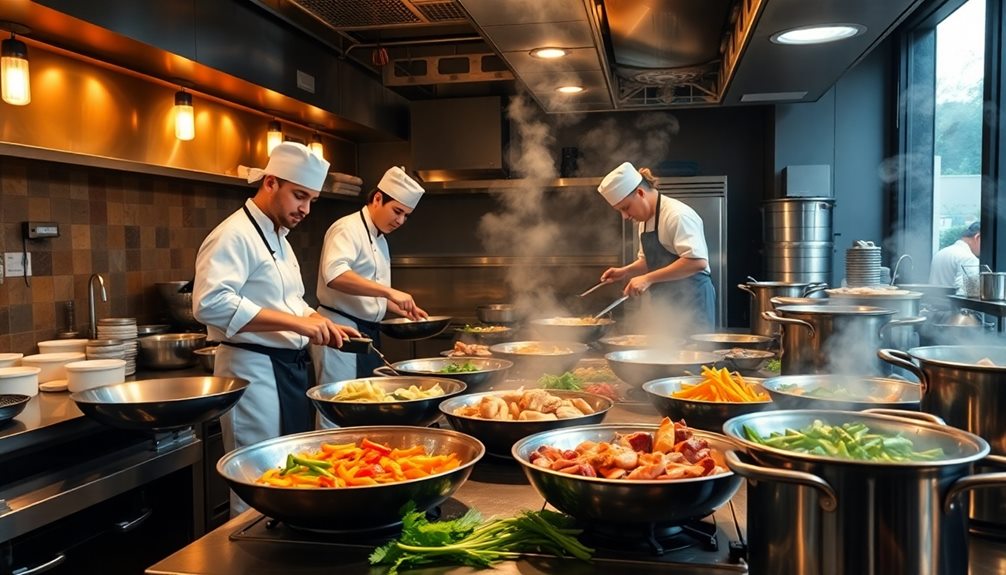
When you think about how restaurants whip up meals in no time, high-heat cooking methods like grilling and sautéing are key players.
They often rely on pre-cooked ingredients to speed up the process, letting chefs focus on finishing dishes quickly.
Plus, an organized kitchen allows them to juggle multiple cooking techniques at once, ensuring everything's ready to serve at the same time.
High-Heat Cooking Methods
High-heat cooking methods are vital for restaurants aiming to prepare food quickly without sacrificing quality. By utilizing techniques that exceed 400 degrees Fahrenheit, you can considerably reduce cooking times and enhance flavor.
Here are three popular high-heat cooking methods:
- Grilling: This method cooks food directly over a heat source, creating a desirable char and smoky flavor while keeping cooking times minimal.
- Sautéing: In professional kitchens, sautéing allows you to cook ingredients quickly in a small amount of oil, resulting in rapid cooking that preserves the food's texture and taste.
- Wok Cooking: This technique excels in stir-frying, where high heat and constant movement guarantee that ingredients cook rapidly without losing moisture.
Other methods like searing meats and flash frying also play a vital role in high-heat cooking. Searing locks in moisture and flavor, while flash frying can complete cooking in just minutes.
Additionally, high-heat induction cooktops are becoming more common in professional kitchens, as they quickly heat pots and pans, further enhancing efficiency.
Embracing these high-heat techniques can streamline your cooking process and elevate your dishes.
Pre-Cooking Techniques
In the fast-paced environment of a restaurant, pre-cooking techniques can be a game changer for enhancing efficiency. By slow-cooking meats like ribs and steaks in broilers, you can guarantee they're nearly finished when an order comes in, allowing for rapid service.
Additionally, prepping ingredients like vegetables in advance and storing them in bins means you can grab what you need quickly during busy periods. Incorporating various toilet types into your kitchen's design can also streamline the process, assuring a clean and efficient workspace.
Bulk cooking plays an essential role here too. When you prepare pasta in large quantities, you can finish it quickly in sauté pans, maintaining both speed and quality. Pre-cooked items, such as chicken and ribs, can be reheated swiftly, ensuring that dishes hit the table promptly without sacrificing flavor or safety.
Utilizing heavy-duty equipment like high-efficiency ovens and steam boxes greatly reduces cooking and reheating times. These methods not only streamline your workflow but also help in managing high volumes of orders, keeping customers satisfied.
Efficient Kitchen Organization
Efficient kitchen organization is key to maximizing speed and productivity in a restaurant. By implementing strategies like mise en place, you guarantee all ingredients are prepped and within reach, allowing for quick assembly during peak times.
Here are three essential components of efficient kitchen organization:
- Batch Cooking: Prepare staples like sauces and gravies in advance. This reduces the time needed during service, enabling you to assemble orders rapidly.
- High-Heat Cooking Techniques: Utilize specialized equipment such as induction cooktops and commercial ovens. These tools considerably cut down cooking times, making it easier to serve dishes promptly.
- Staff Coordination: Designate roles within your team to streamline workflows. Multitasking allows multiple dishes to be prepared and cooked simultaneously, a vital factor in maintaining a fast-paced environment.
Additionally, tools like food processors and steam boxes can enhance efficiency by speeding up prep time and guaranteeing even reheating of pre-cooked ingredients.
Challenges in Fast Service
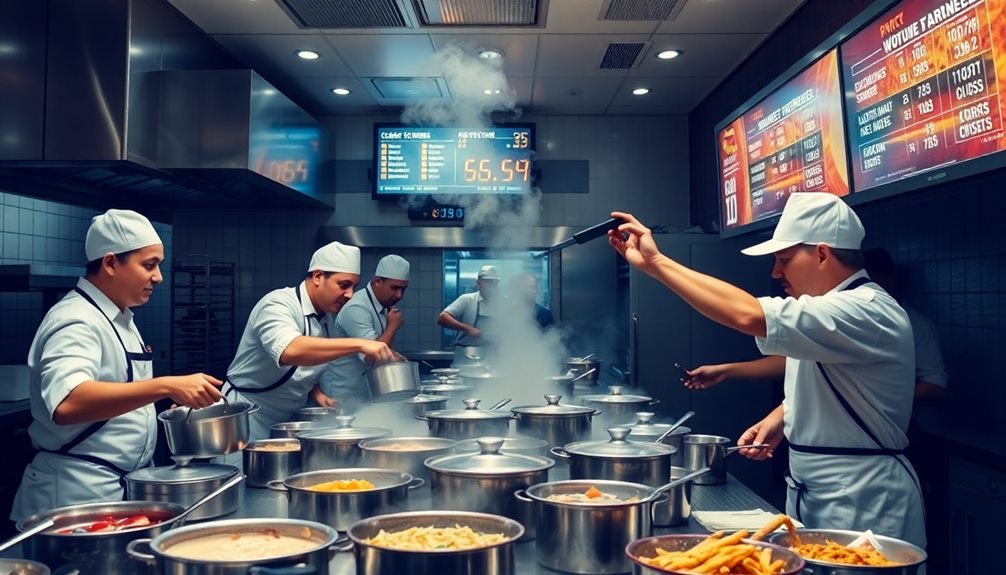
Fast service in restaurants often feels like a high-stakes race against time, with kitchen staff scrambling to meet customer demands. Understaffing during peak hours can lead to service delays, creating traffic jams in the kitchen that slow down meal preparation.
You might notice that effective communication among staff is fundamental for preventing these issues. When everyone's on the same page, orders get coordinated promptly, keeping food at the right temperature and preventing it from becoming cold or overcooked.
In a similar vein, understanding grocery store hours can greatly enhance customer convenience and planning. However, the challenge lies in balancing customer expectations for fast service with the need for quality food. You may see kitchens relying on heat lamps and microwaves as temporary solutions to maintain food quality during these hectic moments. While these methods can help, they often don't match the standards of freshly prepared dishes.
Understanding kitchen workflows is essential to improving the overall experience for customers. It's important to recognize that service delays often stem from the dynamics of a busy kitchen rather than inefficiency.
Frequently Asked Questions
How Do Restaurants Prepare Food so Fast?
You'll notice restaurants prepare food fast by organizing ingredients, using efficient cooking techniques, and employing bulk cooking methods. Their well-coordinated staff and pre-made items enhance speed, ensuring your meal arrives quickly and consistently.
How Is Fast Food Prepared?
When you bite into fast food, you're tasting efficiency. Restaurants prepare it by using pre-cooked ingredients, high-efficiency equipment, and standardized processes, ensuring everything's hot and ready to go in a flash. It's all about speed!
How Do Professional Chefs Cook so Fast?
You'll notice professional chefs cook quickly by organizing ingredients beforehand, using high-heat techniques, and managing multiple dishes at once. Their experience, tools, and teamwork allow them to serve meals efficiently during busy times.
What Makes a Restaurant Fast Food?
Fast food restaurants are like lightning in a bottle; they've mastered speed. You'll find pre-cooked ingredients, specialized equipment, and streamlined layouts, all designed to whip up your favorite meals in record time without sacrificing taste.
Conclusion
In the fast-paced world of restaurants, every second counts. By mastering pre-preparation techniques, utilizing efficient cooking equipment, and fostering staff coordination, you create a seamless experience. You embrace frozen ingredients and quick cooking methods, while balancing flavor and speed. Yet, maneuvering challenges in fast service requires resilience and creativity. When you blend these elements together, you don't just serve food; you serve passion, you serve joy, and you serve unforgettable moments that keep customers coming back for more.
